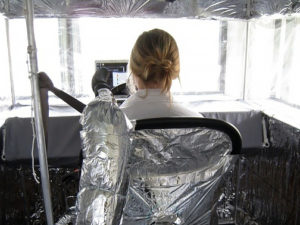The emerging trend toward smart electric vehicles is creating new opportunities for synergistic innovations that are applicable to both buildings and cars. For example, the Tesla Powerwall, which grew out of automobile battery development, now offers a way for buildings to be more grid responsive. Likewise, model-based control concepts, greatly advanced by the automotive sector, are now being tested in the control of complex commercial buildings. These synergies, what we might call the building-automotive nexus, are also reflected in CBE’s body of research on thermal comfort.
While CBE’s research has yielded numerous contributions related to comfort in buildings, many of our signature accomplishments have been supported through studies on comfort in automobiles. Our newest collaborator in these endeavors is the Ford Motor Company, which will be joining CBE’s industry consortium this spring, and will be collaborating with our research team starting this year.

CBE used this mock-up of a car interior to test new cabin conditioning approaches.
Ford will join a group of companies, government agencies and national labs with whom we have collaborated on automotive comfort research in the past: General Motors, Hyundai, Delphi Technologies, Faurecia, the U.S. Department of Energy, the U.S. Army, and the National Renewable Energy Lab (NREL). For example, one of CBE’s key accomplishments resulted from the dissertation work by CBE Research Specialist Hui Zhang, which was supported by NREL and GM. Hui empirically studied temperatures on various parts of the body, as well as overall comfort and thermal sensation, via a comprehensive series of human subject tests. She found that overall discomfort is dictated by the combination of discomfort of individual body parts, and that these ‘local’ effects are not equally weighted. Prior to this research, the human body was treated as a uniform, cylindrical entity. Her dissertation work has been widely published, and led to the development of CBE’s Advanced Thermal Comfort Model, which has been used by our research team and many of CBE’s partners.
CBE’s research team has also applied ideas learned from personal comfort systems (PCS) to the design of automobile cabin conditioning. While PCS are meant to give individuals better comfort control in buildings, this concept also addresses problems that arise in the highly dynamic thermal environments of vehicles. Using CBE’s controlled environment chamber, our researchers built an anteroom and car mockup for human subject tests to compare the effectiveness of various ‘local’ heating and cooling strategies in a test chamber. These strategies provided independent heating and cooling of various parts of the body, for example, using a ventilated car seat, and air vents incorporated into headrests, seat belts and pillars (the supports around car windows). Most recently, in collaboration with MIT’s Senseable City Lab and led by Assoc. Prof. Stefano Schiavon, CBE’s research team is using data from automobile passengers to infer passenger comfort.
The application of CBE’s comfort research to vehicles further supports our goal of understanding how to make better indoor environments. Because Americans spend about 87 percent or our time in buildings, that’s been a natural focus for our work. However, according to a national survey on human activity, we also spend about six percent of time in our vehicles (though when stuck in traffic it feels like more!) With synergistic support and collaboration from both building and automotive sectors, CBE’s research seeks to make broad and important impacts, ultimately moving us in the direction of making smart and resilient cities.

